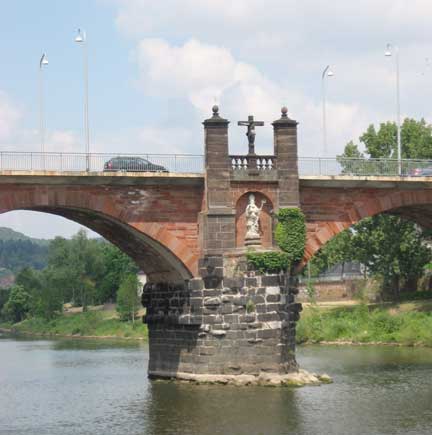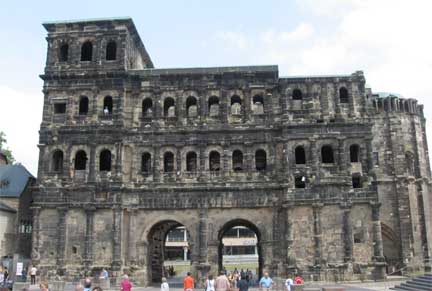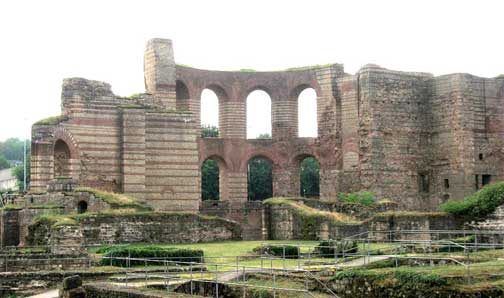

Trier is a mid-sized city located in west central Germany near the border with France and Luxembourg. It has a current population of about 100,000 inhabitants.. It has a strategic location on the Mosel River, one of the largest tributaries of the Rhine. Trier became important to the Romans in the expansion of their empire. As the Mosel runs into the Rhine at Koblenz, not very far from Trier, the town was to be along the "highway" running from Marseille on the Mediterranean through the valleys of the Rhone, Saone and Mosel to the military camp on the Rhine and on to the North Sea. The city was founded as a Roman colony by Augustus, hence its name, Augusta Treverorum, the city of Augustus in the land of the Treveri.
Trier also played a significant role in Catholic Church history as it was the oldest see in Germany. The Archbishop of Trier was one of the seven electors of the Holy Roman Empire.

The Roman bridge pictured above was built as a wooden bridge across the Mosel in 18/17 B.C. It is the oldest standing bridge in the country, and the bridge pillars date back to its construction.
About two hundred years later, around 180 A.D., after Trier had become an urban settlement, the Romans built the Porta Nigra, Made of sandstone, it was a huge gate in the walls of the city. You can see from the picture below why it was called "Porta Nigra."

After the division of the Roman Empire into an Eastern and a Western Empire, Constantine's father, Constantius Chlorus, who lived in Trier, became Caesar (vice-Emperor) of the Western Empire. thus Trier was the official capital and a large area was dedicated to the building of imperial structures. The baths were probably begun in this period. Trier became the seat of the fiscal administration for the entire territory, and the taxes, paid in silver and gold, flowed into Trier. The several Trier mints became the leading mints in the entire empire, and many of the most famous medallions were minted here.
In the early 4th century, when Constantine himself had become Emperor, he lived for a number of years in Trier. He continued the imperial building program, including the baths which were part of an enormous complex containing a large exercise field and an intricate underground water and heating system.

Indeed, even today Constantine's presence is everywhere. He built a huge basilica, a throne room, and with his mother, Helena, began the large cathedral complex. Cycles of damage and restoration have changed the face of these places, but their monumental scale remains.
As the photos show, large stones were used in the construction of the baths. The location of Trier in the Mosel valley is such that the rocky cliffs rising up from the river could have provided sufficient stone for building. The soil is also ideal for growing grapes, and you see many vineyards in the area. Moselle is one of the world's most prized white wines.
Hidaroupe